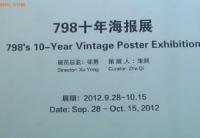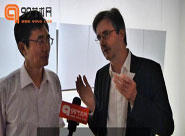The Story of a Mind Mender
In the spring of 2006, at the Landing Art Quarters in the outskirts of Chengdu, I saw the series of works named Imprisonment for the first time and subsequently got acquainted with Luo Jie, a slowly-speaking, mild-tempered and somewhat timid artist. Later, I got to know that Luo Jie had just come to and settled down at Landing to have a studio he had been dreaming of for many years. His unique style of artistic creation also took shape in this period and remains unchanged till now.
Three years have passed, but I still remember distinctly the shock to me when I saw his works at the first sight--- rough ropes tangling together are incarnation of human bodies, whose souls are still lingering around, roaring and rampaging, full of anxiety and agony, and sometimes coldness and confusion. Everything is bewildering, from the disturbingly perilous and violent scenes to the body language representing alienation among and tiredness of people. The seemingly familiar scenes add to fancy and fear all the more. Where has this kind of special and strange visual experience come from? From genetics perspective, the generation of images is rooted in individual experience of life. Then, how to retrieve, awake and present dormant personal memories and transform them into meaningful visual expressions so that they can bear some special symbolic meanings under present social and cultural circumstances? To find an answer to this question, I got interested in Luo Jie’s works.
The contemporary Chinese art was just at a turning point while Luo Jie was studying in Sichuan Fine Arts Institute (SFAI). At the turn of the 1990s, the modern fine arts movement came to an abrupt end because of political events, and the contemporary Chinese art sank into a dormant period, during which the creative atmosphere at Sichuan Fine Arts Institute was very delicate. On one hand, oil painting creation was largely irrelevant to modern art. On the other hand, two painting styles, namely the realistic style, which was ever-increasingly commercialized, and the narrative style, which was ever-increasingly becoming the mainstream, fostered each other. The market was once prevailed by painting dealers from Hong Kong and Taiwan. On the other hand, exploration into modern art by individuals, such as Zhang Xiaogang, Ye Yongqing, Chen Weimin, Yang Shu, Zhang Pin, Xin Haizhou and Guo Jin, etc., never stopped at SFAI but proceeded in a marginal and subtle way instead. More importantly, in 1991, Wang Lin, a critic from SFAI, going against the general trend, planned and organized the Exhibition of Chinese Contemporary Arts For Study, initiated the “discussion on post-1989 art”, and put forward a series of artistic concepts including “political pop art”. It has been 10 years since the inception of this movement and there have been 6 exhibitions, collectively presenting the tendencies in post-1989 art creation in China and encouraging domestic critics to explore the problems with contemporary art as well as the current state of the post-1989 Chinese fine arts. These activities have produced a far-reaching influence on the Chinese contemporary art. With the above three clues, we can basically sketch out the academic environment for Luo Jie at that time: a dull and depressing one, but with the spirit of independence and criticism. Of course, there were also tanks roaring past the gate of the institute and the newly built anti-riot vehicles. This place was near an arsenal, and the roads were also used for the test of ordnance.
The memory of this period in life had a significant influence on Luo Jie’s later creative work. Looking at the images, there are at least three points worthy of deep exploration:
The first is his expressionist tendency. The contemporary Chinese art has an obvious expressionist tendency, and changed from drawing upon the fruits of western art into braving local social and historical problems in quest of an expression full of Chinese experience. Its value lies in its bravery in facing the psychological and spiritual conflicts as well as the opposition by individuals against existence alienation. At the same time, it pays attention to the changes in social ideology and tries to disclose the actual problems hidden behind it. At the turn of the century, the avant-garde spirit of the contemporary Chinese art was facing the encroachment by consumption culture, power capital and post-colonialist culture. Expressionistic creation was overshadowed by conspiracy of interests. Around 2006, Luo Jie did the contrary to the current and expressed the actual experience that had been experienced and was being experienced by China history, society and individuals by exploring deeply into the heart and disclosing spiritual miseries with his series of works named Imprisonment. What dominate his works are the conscience in art and the dignity as an artist rather than “vanity fair” logic.
The second is the symbolic metonymy of his works. Luo Jie is good at transposition, creating misunderstandings between the materialness of non-material and the non-materialness of material. The figures are not lively bodies but moving carriers wrapped up in thick ropes, transformed “creatures” with the external features of humans. In his works, everyday scenes are treated as strange situations, suspended in the cold space unique to the post-industrial era, so that the audience can encounter various problems in the cultural and social reality. This kind of symbolic metonymy not only embodies the strong personal feelings of the artist but also his clear criticism. At the same time, it is also a shift from the realistic painting style to one with conceptual characteristics.

